Salmon River (Mining) District. This district, the largest in Siskiyou County, comprises its entire southwestern corner, and includes the drainage area of the Salmon River and its tributaries. Topographically, it is a tangle of mountain ridges separated by precipitous canyons and river gorges. ... The main gold-bearing rock belt of the county crosses through the middle of this section.
— from a 1916 report by Fletcher Hamilton, State Mineralogist, on the Mines and Mineral Resources of Siskiyou County.
THE BEER TREE
FORKS OF SALMON, Calif.— Someone plunks a couple packs of Keystone Ice and some Coronas on the picnic table under the huge English walnut tree that anchors this rare flat spot in the canyon, and lays a bag of ice on top. It’s a sleepy, hot Friday noon in mid-August. Drivers on the skinny road that hugs the crumbling canyon walls through this remote region near the Humboldt County border holler greetings as they slow to make the sharp curve past the half-dozen miners hunkered at the table and in stray chairs. In an expanse next to the walnut tree, several kids and a mom race around laughing, chased by an overgrown puppy. Across the road a tiny makeshift store gets steady business from the “beer tree” crowd and the passing cars. Nearby is the Forks of Salmon School and a post office.
Noon wanes into afternoon; hands reach for fresh beer, others snap open soda pops. Someone lights a joint and the gab intensifies. Old mining. New mining. The rollicking past. The uncertain future.
“They want to clear out all the small-scale miners,” says Chad Stanford, halfway down the afternoon’s conversation.
“And they won’t come at you face on,” says his dad, Bill. The two have claims a few miles from here. “They’ll use law, paperwork, rules, regulations and police to run people outta here.”
It seems to be a preoccupying fear in this crowd — eviction.
And now they’re decrying the notion that dams on the Klamath and suction gold mining dredges there and here on the Salmon are mucking the water and hurting fish populations. Rex Russell gets excited and reaches into a pocket, pulls out a small bottle and passes it around. No, not a glass vial of sunshiny gold flakes. Each miner examines the bottle then swigs a sample of the green liquid: algae from Klamath Lake that a “lady friend” of Russell’s is marketing as a health tonic. It’s called “Resistance.”
Well, the name sure is fitting : To listen to these miners talk, there is much to resist. Nothing but grief from all directions: the feds, the state, the Karuk Tribe, the environmentalists and even, though they hate to admit it, certain other miners — like those New 49’ers who came in a few years ago en masse , laying claim to everything in sight, crowding into the river with their dredges and drawing an unwelcome spotlight onto all dredge mining in the Salmon River. Why, the last of the small-time miners here — the suction dredge miners, specifically, the ones who scour the streambeds for loose specks of gold — might soon have to flee for other hills. Or other lives.
GOLD
The main gold-bearing belt of Siskiyou County consists of meta-morphic slates, granites, diorites, and limestones, with occasionally intrusive masses of porphyry, trap and syenite. This belt is from 5 to 12 miles in width and about 60 miles long, widening and narrowing at places on its line of strike, which varies from N. 20’ to 30’ E. In some places it is veined and seamed with stringers of quartz; in others it is soft, carrying talc in excess, with irregular bunches of quartz, rich in gold... .
— Hamilton, Mines and Mineral Resources of Siskiyou County , 1916.
The Salmon River begins as snowmelt that seeps, trickles, then gushes through a steep accordion of ridges and wooded canyons: From the Marble Mountains and Russian Wilderness come the waters of the North Fork of the Salmon, and from the Trinity Alps and Salmon Mountain Wilderness come the waters of the South Fork. They merge into one long, winding, deep-pooling, see-through emerald-and-jade current that slips — undammed — between stands of fragrant pines, oaks, firs and peeling red-barked madrones, wraps around jumbled bright granite boulders and nibbles away at gravel-packed ledges, quartz-veined cliffs and slaty bedrock. Along the way, more cold creeks flow in: Crapo, Nordheimer, Morehouse, Portuguese, Butler, Wooley. Seventeen miles downstream from where the forks merge, the Salmon River joins the Klamath and continues the plunge toward the sea.
But our story begins back at the Forks of Salmon. It was around about here, on a June day in 1850, that the river-tumbled cobbles and sands finally yielded what prospectors had been searching for: flakes and nuggets of gold. The ensuing spree lasted for more than a hundred years, with the Liberty Mining District — just upstream on the North Fork — at one point yielding so much gold, mostly pried from hard rock, that the region was the second largest gold producer in California, next to the Mother Lode in the Sierras.
THE BEER TREE
“Turn of the [20th] century, there were probably 5,000 miners living in here,” says Chad Stanford, sitting in a chair next to the picnic table under the English walnut tree. He and his dad, Bill — beside him in another chair — have worked two claims up the North Fork, the Bear Hide 3 and 3Bs, since 1990. They’ve umpteen problems with the Forest Service, they complain. Not least, the Service’s decades-long plan to evict people living on their claims.
“Now there’s about 20 who live here!” says Bill, 62, a retired logger and pizza chain owner who lives near Modesto when he isn’t up here mining. Like a few of the other older miners sitting around the table, Bill Stanford is a Vietnam veteran. He’s got a direct, personal way of looking at someone, with a mix of vulnerability and hardness in his eyes. You like him. You don’t want to defy him.
“They finally got Lloyd off,” says Chad. “And we’re on our claim till September.” They don’t know what will happen then. “There used to be beautiful homes on the claims here.”
“There was probably a house every half mile up the river, till the big push to get ’em off,” says Richard Cormier, a resident miner.
THE FOREST SERVICE
It was raining on the day, in 1999, that Richard Cormier and his wife, Mayanna, set fire to their house and said goodbye to their wild perch between the narrow, landslide-prone canyon road and one of the best swimming holes on the main stem of the Salmon River. They’d courted down there, years before, where the green water pools deep against the white granite: him, a handsome long-haired miner in Speedos living on the beach; her, a pretty Danish woman come out to these woods to visit her sister. She had stopped by to have him fix her motorcycle and the rest is history. They made a home in the vertical-log house that was already there amid the lichen-covered live oaks, brought water down a pipe from Duncan Creek for power, built an outdoor bedframe on the edge of the cliff, planted a garden and made friends with just about everyone who drove up and down the highway.
“It was like the Road House,” recalls Cormier. “People were constantly stopping by.”
But the claim and house were on public land. Most of the land surrounding the Salmon River is in the Klamath National Forest, although the next-door Six Rivers National Forest manages the lower 13 miles of the river’s main stem out of logistical practicality. More than 98 percent of the mining claims here are on national forest land.
Cormier and his wife, like others, lived on their claim by the grace of the 1872 Mining Act, which allows people to prospect and take minerals from public land and, at least in the old days, live on that land as well. But when Cormier bought the place in 1987, he knew the tide was changing against residential occupation of national forest mining claims.
“I was told by the Forest Service, ‘Don’t buy this place, because we’ll have you out in six months,’” he says. “But I bought the claim, and the house — paid $20,000 for it. And I made a living here for 12 years, dredging. [The Forest Service] harassed me the whole time.”
Finally, the Cormiers forfeited their claim to the Forest Service and left. And since they were required to remove all structures and equipment when they left, they did the easiest thing: burned the house down. “It’s what the Forest Service does,” says Cormier.
They weren’t the only ones evicted. In the 1960s, the Forest Service had begun scrutinizing mining claims and discovered many were occupied by residents who no longer were seriously mining — maybe their paystreaks had run out, or they’d grown old, or they were doing other things.
Hundreds of such residents got the boot, and their houses were burned down, with the greatest “purge” on the Salmon River occurring in the 1980s and 1990s. The region emptied. Hilton Cass, the Forest Service’s minerals administrator for Region 5, which includes the Salmon River, says a few elderly claim dwellers were granted a life-tenure permit to stay in their homes; when they moved or died, their claims could not be transfered to someone else and their structures would become Forest Service property.
These days Cormier mines outside of Forest Service territory on the South Fork, where he and his wife built a new house, working eight acres of dredged tailings at a private gold mine patented in the 1890s. But he’s still bitter about what happened to his old claim site after he left it.
“The Forest Service let the New 49’ers move in,” he says.
THE BEER TREE
Jessie Allen, the Forks of Salmon postmistress, has just got off work and wandered across the road to join the conversation at the beer tree. A youthful middle-aged woman, one-quarter Karuk Indian with dark curly hair, Allen was born in the Hoopa Valley and moved to the Forks of Salmon in 1967, when she was 13. She’s mined all her life, first on the Starveout claim passed down through her family since 1913. “My ex and I did $6 an hour in the ’80s,” she says. “We lived off it, the four of us.” Now she dredge mines on the Eel Rock claim on the South Fork.
It was there that she — along with much of the rest of the indie mining folks — first encountered a new threat to their way of life: a club for amateur gold-seekers from the city called the New 49’ers Club, which was vastly expanding its operations a few years ago. In 2003, the New 49’ers Club’s founder, Dave McCracken, came into the Salmon River mining district and started staking claims. Many of the spots he claimed in that year were ones abandoned by miners during the Forest Service “purges.” But according to Allen, in some cases McCracken didn’t even bother to check if people were still mining on some of the territory he was claiming as his.
“They came in and blanket-claimed over everybody,” Allen says. “McCracken, he posted right on top of my sign. I jumped his face — he was putting a sign on a neighbor’s place. And he said, ‘I’ll see you in court.’ But he took his signs down. They got a lot of flack from people.”
“With the New 49ers, you get an influx of people who haven’t been taught good woods etiquette,” says Bill Stanford, grabbing another Keystone Ice. “They come up here, they’re used to the city type of life, they leave a lot of garbage and they don’t keep their gas away from the river — a bear can come by and slop that into the water.”
“The problem was,” adds Richard Cormier, “they came in and put 15 dredges in a half-mile stretch of river.”
THE NEW 49’ERS
Dave McCracken is a master promoter.
“60 miles of mining property,” shouts the top of his website.
“Hey,” it continues, “did you know there is still a lot of gold to be found today? It’s true; experts say that only 5% of all gold has been found. I’m Dave McCracken and I founded The New 49’ers Prospecting Association 20 years ago for the purpose of providing the best, and the most, small-scale gold mining opportunities available to you anywhere in America. And I have done it!”
His isn’t the only mining club in these parts; the Lost Dutchman’s Mining Association has some claims, too. But McCracken’s outfit seems more, well, as he’d put it, friendly and family-oriented. It’s boisterous. And he is even more convincing in person, or in the case of an interview last August, by telephone: “When you’re down there on the bottom of the river,” he said, “and you’re in a crack, and you disºcover gold nuggets that no one’s ever seen before — it gets you where you live , girl. It’s the feeling of winning the lottery, though better than that. It’s exhilaration!”
It costs $3,500 for a full membership, which allows you to set up a dredge on claims owned by the club. McCracken holds field training sessions on mining techniques, and week-long group mining outings. More than a thousand people have joined the New 49’ers, and a lot of them started showing up on the Salmon River starting in 2003, after they read about the 12 miles of new claims McCracken had staked there on the main stem.
Their sudden descent raised the hackles of just about everyone in the community. There was a meeting at which, reported Salm Stroich later in The River Voice , a newsletter for the Salmon and mid-Klamath region, people complained about one club campsite with “two dozen people crowded into it ... washing their clothes and bathing, using detergents and soap, directly in the river in the area just up river from Duncan Creek.” Boaters said they’d been deafened by multiple dredges operating at once in the canyon, Stroich reported. And everybody knew about the dredge that had flipped, spilled fuel in the water, and run into a “screw trap” the Karuk Tribe’s fishery department uses to monitor juvenile fish.
New 49’ers members, meanwhile, complained in their club’s website forum of their dredges being cut loose, vandalized or stolen. And of more serious harassment.
“People were driving by and shooting at dredges, or honking their horns and screaming,” recalls Richard Cormier. “Tires were flattened.” Cormier has some history with McCracken — he took a dredging class on the Trinity River from him and they even ran a dredge together until they had a falling out.
Cormier decided one day to go warn a recently arrived elderly couple in the club, now enjoying his old homesite, about how rowdy things had gotten. “I think I told them, things were going to get worse before they got better,” he says. “And that I was harassed, too, when I first moved there, but then people accepted me.”
He also mentioned that he thought that McCracken was taking them for a ride about how much gold was left on that claim. He thought they left on good terms. Apparently not.
“Next thing I know, at 11 o’clock at night here comes the Sheriff to my house,” Cormier says. The jumpy clubbers had taken his cautions as a threat.
In the phone interview last year, McCracken said he had sensed the displaced old-time miners’ unhappiness. “They watched us move in, saw our porta-potties go up, and they were like, ‘What happened?’” He said the district ranger at the time allowed the club to set up campgrounds on a couple of vacated spots. “So it looked like we invaded,” McCracked admitted. “And there we were, in their face. Well, so what I did was, I just redirected away from the Salmon River.” In 2005, he started to concentrate his operations on the Klamath instead.
Bill Stanford at his claim.
Well, actually, the Orleans District, under new district rangers, started asking McCracken’s club to file detailed plans of operation for its claims. And that, said Bill Rice, who that year became the district ranger of the Orleans District, which manages the lower 13 miles of the main stem Salmon, caused McCracken’s retreat.
“They could never tell me how many miners could descend on any particular claim at any one time,” said Rice. “And McCracken, he was doing these classes, and he might have two to five dredges at one spot. I found I could only accept two dredges per mile.” Rice also told miners they could only camp in established campgrounds, they had to keep their dredges out of swimming holes and away from where cold streams came into the river, and they had to replace the cobbles in the holes they dug while dredging.
“I didn’t say they couldn’t mine,” Rice said. “I don’t think I’m the big, bad ogre with the miners.”
By 2007, McCracken’s retreat from Rice’s domain was complete. Early this year, the club auctioned off its main stem Salmon claims. Cormier says his old claim went for more than $50,000.
THE KARUK TRIBE
The New 49’ers had been dredging on the main stem of the Klamath River above Happy Camp for 20 years, said Karuk Tribe Vice Chairman Leaf Hillman in an interview in February 2006 at his Orleans office. “And while we certainly weren’t happy about it, it was on the main stem,” Hillman said. “Then they got quiet.”
But in 2003, Hillman said, Dave McCracken “looked down the river, down this way, and he saw there were a lot of mining claims down here. ... Once he secured all the claims, then he went on his big advertising and promotion campaign: ‘Hey, the new gold strike! Hey, come be part of this action! The biggest gold strike since 1850!’ And it worked really well.”
Miners rushed to the Salmon River — and onto sacred places such as Katimin, the Center of the Karuk World and the place where the Salmon joins the Klamath. “Any place you could get off the road was occupied by New 49’ers’ trailers and campers,” Hillman recalled. “And everywhere you looked on the river was a dredge.”
Hillman said he hadn’t minded the miners who’d lived on the claims before.
“All those years, those old miners, I never felt a bias toward them,” he said. “They were just hippies and okies. They didn’t tear things up. They were conscientious of how they did things. They were hardworking and they were part of this community.
“But the ‘New 49’ers’ — as Karuk people, this strikes a chord very deep. The old 49ers, the ones from 1850 — we were one of the last places where contact occurred between Europeans and native people. Between 1850 and 1870, 60 percent of our indigenous population was wiped out by disease and hunger. An additional 20 percent were murdered, killed, rubbed out by miners and settlers. It’s not ancient history — it’s a mere smidgen over 150 years ago. ... Empires throughout the world have been founded on gold, and it continues to be the root cause of genocide. ... And the jury’s still out whether or not we’ll ‘survive’ contact. ‘New 49’ers’: The name inspires rage in me.”
McCracken, the Forest Service and the Karuks met several times to try to work things out. But still the Karuk Tribe sued the Forest Service, accusing it of being too lax when it came to sanctioning and monitoring suction dredge operations. The tribe lost the suit, appealed, and it’s now in the 9th Circuit Court. Then the Karuk sued the California Department of Fish and Game, saying it had failed to update its regulations prohibiting suction dredge mining in rivers occupied by species listed as threatened, endangered or of concern. The regulations were based on a 1994 environmental impact report. Since then, the Coho salmon, green sturgeon and Klamath River lamprey, among others, had been listed, but DFG regulations hadn’t reflected the change. In late 2005, the two parties reached a settlement that banned suction dredge mining on the main stem of the Salmon River and on dozens of tributaries to the Klamath and Salmon, and placed greater restrictions on when dredgers could operate elsewhere.
Outraged and surprised, the New 49’ers sued to intervene, saying they’d been denied the opportunity to partake in the settlement. Miners’ website forums crackled with indignation, and sometimes something worse. In a December 2005 posting to a forum on the website “49er Mike’s Prospectors Cache,” a “Reed Lukens” responded to 49er Mike’s alert about the Karuk-DFG deal: “And it happened behind our backs ... 150 years ago the miners would just have killed them all for this.”
In December 2006, the court ruled in the miners’ favor, saying the Karuk and DFG had wrongly left the miners out of the process. The court ordered the DFG to prepare an updated environmental document on suction dredging by mid-2008. Both sides — the miners and the Karuk — are hoping that the document will fall in their favor. But funding problems at DFG have stalled the review, and now no one is sure when it will get done.
THE BEER TREE
“The old miners left a mess,” says Rex Russell. “The old miners hydraulicked everything down the hills [with giant water canons] and left a mess.”
“The rivers would almost run red from all that hydraulic mining,” says Bill Stanford. “But that algae, and micronutrients, would settle in the estuaries and become food for shellfish and small fish.”
Sure, the miners agree, the salmon in the basin have declined. But was it because of modern dredge mining? Or even the dams on the Klamath? Some shake their heads, declining to handle the hot potato topic of Klamath dams.
“The off-shore fishermen, they’re taking tons and tons of salmon,” says Bill. “And you never see ’em.”
“It’s the foreign fisheries,” agrees Richard Cormier. And what about recreation? “You’ll get 20 people in a swimming hole — how much shit does that stir up? And nobody ever says anything about that.”
On the Salmon River, rising water temperatures also hurt, says Jessie Allen. “The holes used to be black with the backs of fish,” she says. “They started decreasing in the 1970s, and they really dropped in the 1980s. The water temperature rose. There wasn’t enough snowmelt to keep it cold.”
THE FISH
“We have lethal water temperatures on the Salmon River,” said Will Harling, speaking by phone in early August from his office in Orleans. He’s the program coordinator for the Mid Klamath Watershed Council, which does restoration projects in the mid-basin to protect anadromous fisheries. “The water is 78 degrees.” Seventy-two or 73 degrees would be tolerable, he said. “But you have this warm water already, and the fish are dying of gill rot disease.”
The reason this scares people is the Salmon River harbors the last continuous population of spring-run Chinook salmon in the Klamath watershed. Likely, this is because the river is undammed, less impacted than other rivers and has a number of clean cold-water creeks rushing in that create refugia for salmon during the hot summer.
Rebecca Quiñones, a biologist with the Klamath National Forest and graduate student at U.C. Davis, said there used to be spring-run Chinook throughout the Klamath River Basin. They’d come in from the ocean in May and June and hang out in the rivers and tributaries until they spawned in the fall. Dams, hydraulic mining, agriculture, logging and canneries devastated spring-run Chinook populations. Now, mostly what is left in the region are fall-run Chinook, who come into the rivers July to September. And two years ago, the spring-run Chinook population in the Salmon River took a nose dive to just less than 90 individuals. This summer, however, biologists counted about 840 individuals.
“That’s still way below a healthy number for that population,” said Quiñones. “In the whole Klamath watershed, there should be 100,000 spring Chinook. When you have a species with much diversity, you have more of a buffer from a variety of impacts. Without diversity, you get genetic deterioration, so you’re less adaptable to future change.”
Steelhead in the Salmon River have also declined — just 30 adults were counted in the river this summer.
Curiously, the Salmon River wasn’t historically the best salmon and trout producer. “It doesn’t have as many nutrients,” Quiñones said. And the east-west orientation of the river naturally lets in more sunshine, so water temperatures have always risen a bit high in the summer. “And also, with climate change, we are seeing less snowmelt, and so even warmer temperatures.”
And so adding one more potential impact to the river — say, suction dredge mining — can’t be a good thing, say the biologists.
Prove it, say the dredgers. Miners — club and independent ones — say they actually see fish hanging out by their dredges, eating all the good stuff stirred up by the suction hose. According to attorney James Buchal, who represents the new 49’ers, one biologist found that “the only place fish can survive is in cold water holes left behind by dredges.” The dredges remove silt, said Buchal, that otherwise would clog up the salmons’ spawning gravels. Sure, fish eggs could get sucked into the suction hoses. “That’s why you can’t dredge when the eggs are in the gravel.”
But biologist Peter Moyle of U.C. Davis, who has done extensive research on the Salmon River fisheries, said there are many potential impacts. Gravels displaced by dredging become unstable for spawning redds. Other sensitive fish species’ eggs could be getting eaten by the salmon hanging around the dredges. And so on. Even the miners agreed to stop dredging for a day this July while the annual “fish count” took place on the Salmon River, Moyle said. “When large sections of a normally clear river are cloudy with silt for much of the summer, how can that be good for fish, especially endangered salmon?” asked Moyle.
It’s a question being entertained in a much broader arena, these days, as a bill that would allow the DFG greater authority to restrict or ban dredging on certain rivers works its way through the state legislature. Under AB 1032 — “Native Trout, Aquatic & Amphibian Species Protection” — the DFG would be able to close a stream, either altogether or seasonally, to motorized suction gold dredging to protect wild trout and aquatic species listed as threatened, endangered or of special concern. It would affect at least 5 percent of the 20,000 miles of streams in California, according to the bill’s author Assemblywoman Lois Wolk.
Jeff Shellito of CalTrout, a nonprofit fish conservation group that is pushing for AB 1032, said that the bill would force the DFG to carry out obligations that would have been met had its settlement with the Karuk not landed in limbo.
And that might make it difficult, if not impossible, for some independent miners to continue dredge mining in places like the Salmon River. If the bill does pass, it might be the final straw for that long-suffering group of people gathered underneath the beer tree, who find in this place and this occupation a way to escape from civilization and live wild for a few months. Or a lifetime.
If it doesn’t — why, they’ll still have plenty to complain about.
THE BEER TREE
“I was on a claim,” says Rex Russell, a harried, gentle-seeming man with a gold-nugget earring. He’s sitting at the table with a stack of legal papers in front of him that keeps getting scattered by a capricious breeze.
The 58-year-old Russell — also a Vet, and somewhat ravaged by injuries from a car wreck — had a gold claim (hard rock, not placer) and, more profitably, a slate operation down near Slate Creek, by the Klamath River. For 15 years he excavated slate and sold it to landscapers and masons at $500 a ton. Alas, he’s been booted off, for not filing an adequate plan of operations, among other things. The Forest Service says he even once started a fire they had to put out. He is forbidden to return to national forest lands without permission from the district ranger; and now, Russell says, he must report to a halfway house in Oakland to do six months time for his run-ins with law enforcement. It’s a long story, involving a probation violation, trespassing, a pot charge and the not very small matter of his kicking one of the officers when they came to his cabin.
“You shouldn’t have kicked him,” says Chad.
“I hope you got a good kick in,” says Bill. Then he says, “They were threatening me with jail, too. For ‘trespassing on Forest Service land.’ And my waterline, they complained about that, said I had to remove it.” The agency didn’t like the sprinklers the father and son had put in. And it said they could no longer use the old, unsafe bridge that crosses their camp between their two claims. So now, says Chad, it’s harder to get their dredge equipment to that part of the river.
Three years ago, says Bill, he was sick and wanted to be able to hook his heart monitor to a phone out at the mining claim so a doctor could check it. But the Forest Service said no to a phone line, so he went home to Modesto early that summer.
Meanwhile, his son Chad got in trouble for staying at their camp longer than the Forest Service said he was allowed to. But the agency’s occupancy regulations aren’t clear, says Chad. The Forest Service is aware of that. It’s lost two cases already against miners who sued it for kicking them off their claims, and is in the process of updating the regulations right now.
“You don’t know, one year to the next, what they’re gonna do or what they’re gonna say,” says Bill. “So how can you plan a thoughtful operation?”
“They came up in the morning,” recalls Rex Russell, returning to his tale, “I’m in my bunk, and they said, ‘You’re going to have to move.’ Then they said I pointed a weapon at them. I had a crossbow. But I didn’t point it at ’em. That’d be stupid — they’d shoot me. I have the crossbow because the civet cats come in the house — oh, they eat everything .”
“They tried to supercede the law,” says Chad. “The 1872 Mining Law says we have a ‘right of possession and enjoyment’ of mining claims.”
“And this is one of the last of our American rights,” says Bill. “People can go and get their worth from the earth.”
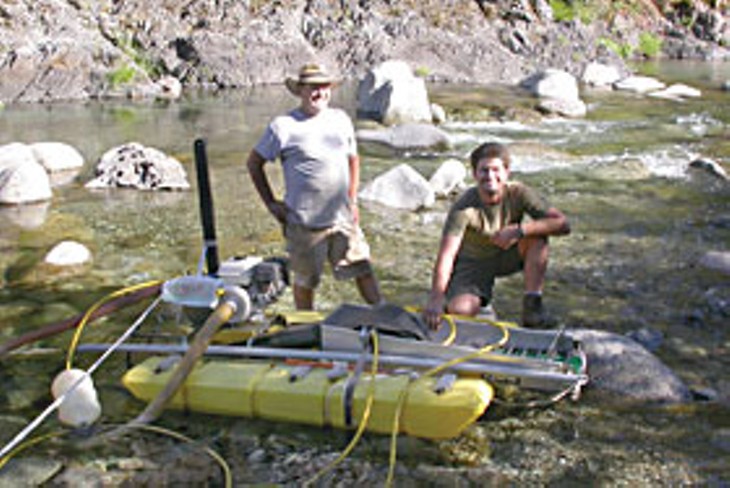
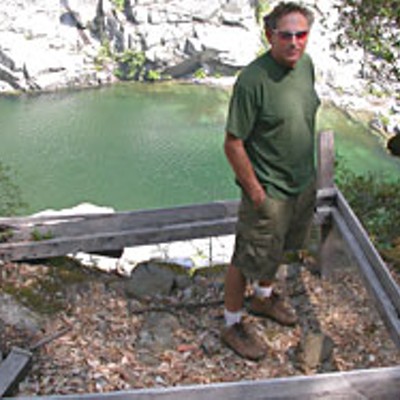
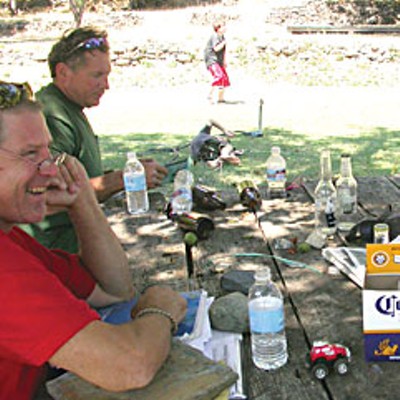
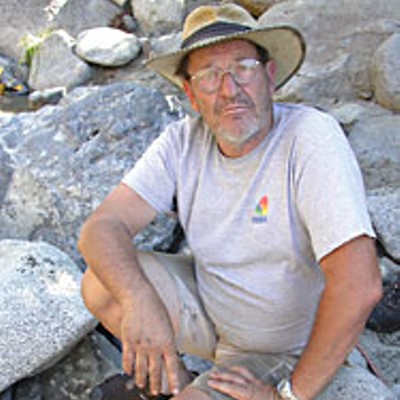
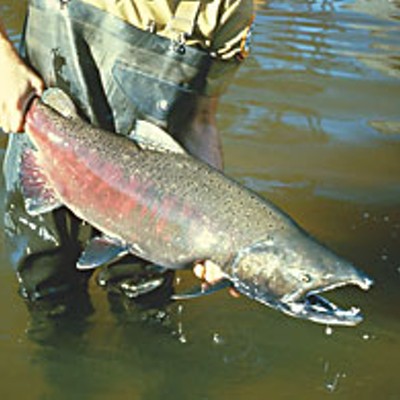
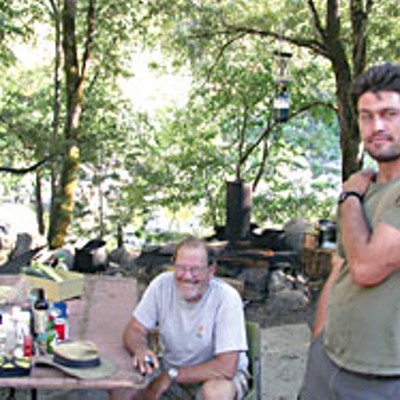

Comments